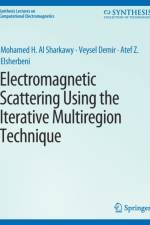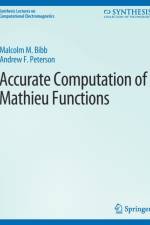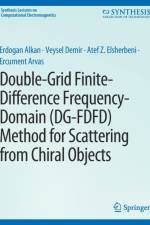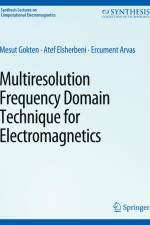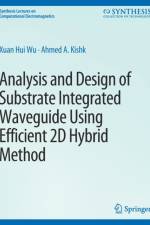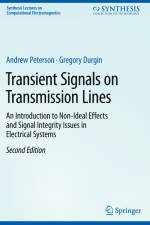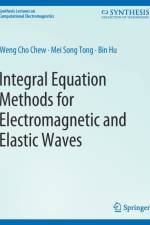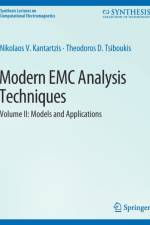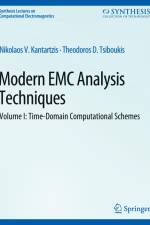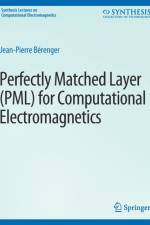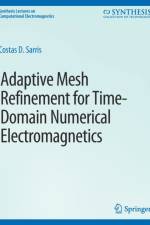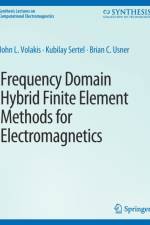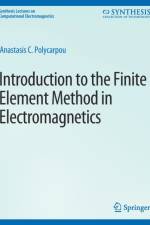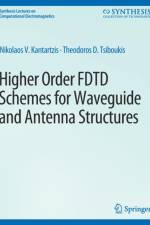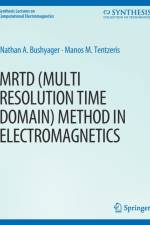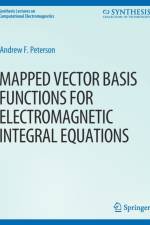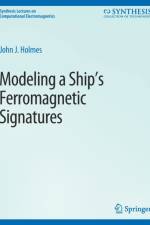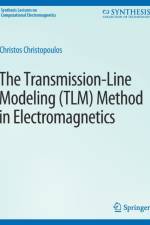Bøger i Synthesis Lectures on Computational Electromagnetics serien
-
371,95 kr. In this work, an iterative approach using the finite difference frequency domain method is presented to solve the problem of scattering from large-scale electromagnetic structures. The idea of the proposed iterative approach is to divide one computational domain into smaller subregions and solve each subregion separately. Then the subregion solutions are combined iteratively to obtain a solution for the complete domain. As a result, a considerable reduction in the computation time and memory is achieved. This procedure is referred to as the iterative multiregion (IMR) technique. Different enhancement procedures are investigated and introduced toward the construction of this technique. These procedures are the following: 1) a hybrid technique combining the IMR technique and a method of moment technique is found to be efficient in producing accurate results with a remarkable computer memory saving; 2) the IMR technique is implemented on a parallel platform that led to a tremendous computational time saving; 3) together, the multigrid technique and the incomplete lower and upper preconditioner are used with the IMR technique to speed up the convergence rate of the final solution, which reduces the total computational time. Thus, the proposed iterative technique, in conjunction with the enhancement procedures, introduces a novel approach to solving large open-boundary electromagnetic problems including unconnected objects in an efficient and robust way. Contents: Basics of the FDFD Method / IMR Technique for Large-Scale Electromagnetic Scattering Problems: 3D Case / IMR Technique for Large-Scale Electromagnetic Scattering Problems: 2D Case / The IMR Algorithm Using a Hybrid FDFD and Method of Moments Technique / Parallelization of the Iterative Multiregion Technique / Combined Multigrid Technique and IMR Algorithm / Concluding Remarks / Appendices
- Bog
- 371,95 kr.
-
371,95 kr. This book is the first of two volumes which have been created to provide an understanding of the basic principles and applications of electromagnetic fields for electrical engineering students. Fundamentals of Electromagnetics Vol 1: Internal Behavior of Lumped Elements focuses upon the DC and low-frequency behavior of electromagnetic fields within lumped elements. The properties of electromagnetic fields provide the basis for predicting the terminal characteristics of resistors, capacitors, and inductors. The properties of magnetic circuits are included as well. For slightly higher frequencies for which the lumped elements are a significant fraction of a wavelength in size the second volume of this set, Fundamentals of Electromagnetics Vol 2: Quasistatics and Waves, examines how the low-frequency models of lumped elements are modified to include parasitic elements. Upon completion of understanding the two volumes of this book, students will have gained the necessary knowledge to progress to advanced studies of electromagnetics.
- Bog
- 371,95 kr.
-
371,95 kr. This lecture presents a modern approach for the computation of Mathieu functions. These functions find application in boundary value analysis such as electromagnetic scattering from elliptic cylinders and flat strips, as well as the analogous acoustic and optical problems, and many other applications in science and engineering. The authors review the traditional approach used for these functions, show its limitations, and provide an alternative "e;tuned"e; approach enabling improved accuracy and convergence. The performance of this approach is investigated for a wide range of parameters and machine precision. Examples from electromagnetic scattering are provided for illustration and to show the convergence of the typical series that employ Mathieu functions for boundary value analysis.
- Bog
- 371,95 kr.
-
457,95 kr. This book describes and illustrates the application of several asymptotic methods that have proved useful in the authors' research in electromagnetics and antennas. We first define asymptotic approximations and expansions and explain these concepts in detail. We then develop certain prerequisites from complex analysis such as power series, multivalued functions (including the concepts of branch points and branch cuts), and the all-important gamma function. Of particular importance is the idea of analytic continuation (of functions of a single complex variable); our discussions here include some recent, direct applications to antennas and computational electromagnetics. Then, specific methods are discussed. These include integration by parts and the Riemann-Lebesgue lemma, the use of contour integration in conjunction with other methods, techniques related to Laplace's method and Watson's lemma, the asymptotic behavior of certain Fourier sine and cosine transforms, and the Poisson summation formula (including its version for finite sums). Often underutilized in the literature are asymptotic techniques based on the Mellin transform; our treatment of this subject complements the techniques presented in our recent Synthesis Lecture on the exact (not asymptotic) evaluation of integrals.
- Bog
- 457,95 kr.
-
371,95 kr. This book presents the application of the overlapping grids approach to solve chiral material problems using the FDFD method. Due to the two grids being used in the technique, we will name this method as Double-Grid Finite Difference Frequency-Domain (DG-FDFD) method. As a result of this new approach the electric and magnetic field components are defined at every node in the computation space. Thus, there is no need to perform averaging during the calculations as in the aforementioned FDFD technique [16]. We formulate general 3D frequency-domain numerical methods based on double-grid (DG-FDFD) approach for general bianisotropic materials. The validity of the derived formulations for different scattering problems has been shown by comparing the obtained results to exact and other solutions obtained using different numerical methods. Table of Contents: Introduction / Chiral Media / Basics of the Finite-Difference Frequency-Domain (FDFD) Method / The Double-Grid Finite-Difference Frequency-Domain (DG-FDFD) Method for Bianisotropic Medium / Scattering FromThree Dimensional Chiral Structures / ImprovingTime and Memory Efficiencies of FDFD Methods / Conclusions / Appendix A: Notations / Appendix B: Near to Far FieldTransformation
- Bog
- 371,95 kr.
-
371,95 kr. In this book, a general frequency domain numerical method similar to the finite difference frequency domain (FDFD) technique is presented. The proposed method, called the multiresolution frequency domain (MRFD) technique, is based on orthogonal Battle-Lemarie and biorthogonal Cohen-Daubechies-Feauveau (CDF) wavelets. The objective of developing this new technique is to achieve a frequency domain scheme which exhibits improved computational efficiency figures compared to the traditional FDFD method: reduced memory and simulation time requirements while retaining numerical accuracy. The newly introduced MRFD scheme is successfully applied to the analysis of a number of electromagnetic problems, such as computation of resonance frequencies of one and three dimensional resonators, analysis of propagation characteristics of general guided wave structures, and electromagnetic scattering from two dimensional dielectric objects. The efficiency characteristics of MRFD techniques based on different wavelets are compared to each other and that of the FDFD method. Results indicate that the MRFD techniques provide substantial savings in terms of execution time and memory requirements, compared to the traditional FDFD method. Table of Contents: Introduction / Basics of the Finite Difference Method and Multiresolution Analysis / Formulation of the Multiresolution Frequency Domain Schemes / Application of MRFD Formulation to Closed Space Structures / Application of MRFD Formulation to Open Space Structures / A Multiresolution Frequency Domain Formulation for Inhomogeneous Media / Conclusion
- Bog
- 371,95 kr.
-
457,95 kr. Introduction to the Finite-Difference Time-Domain (FDTD) Method for Electromagnetics provides a comprehensive tutorial of the most widely used method for solving Maxwell's equations -- the Finite Difference Time-Domain Method. This book is an essential guide for students, researchers, and professional engineers who want to gain a fundamental knowledge of the FDTD method. It can accompany an undergraduate or entry-level graduate course or be used for self-study. The book provides all the background required to either research or apply the FDTD method for the solution of Maxwell's equations to practical problems in engineering and science. Introduction to the Finite-Difference Time-Domain (FDTD) Method for Electromagnetics guides the reader through the foundational theory of the FDTD method starting with the one-dimensional transmission-line problem and then progressing to the solution of Maxwell's equations in three dimensions. It also provides step by step guides to modeling physical sources, lumped-circuit components, absorbing boundary conditions, perfectly matched layer absorbers, and sub-cell structures. Post processing methods such as network parameter extraction and far-field transformations are also detailed. Efficient implementations of the FDTD method in a high level language are also provided. Table of Contents: Introduction / 1D FDTD Modeling of the Transmission Line Equations / Yee Algorithm for Maxwell's Equations / Source Excitations / Absorbing Boundary Conditions / The Perfectly Matched Layer (PML) Absorbing Medium / Subcell Modeling / Post Processing
- Bog
- 457,95 kr.
-
371,95 kr. Substrate integrated waveguide (SIW) is a new type of transmission line. It implements a waveguide on a piece of printed circuit board by emulating the side walls of the waveguide using two rows of metal posts. It inherits the merits both from the microstrip for compact size and easy integration, and from the waveguide for low radiation loss, and thus opens another door to design efficient microwave circuits and antennas at a low cost. This book presents a two-dimensional fullwave analysis method to investigate an SIW circuit composed of metal and dielectric posts. It combines the cylindrical eigenfunction expansion and the method of moments to avoid geometrical descritization of the posts. The method is presented step-by-step, with all the necessary formulations provided for a practitioner who wants to implement this method by himself. This book covers the SIW circuit printed on either homogeneous or inhomogeneous substrate, the microstrip-to-SIW transition and the speed-up technique for the simulation of symmetrical SIW circuits. Different types of SIW circuits are shown and simulated using the proposed method. In addition, several slot antennas and horn antennas fabricated using the SIW technology are also given. Table of Contents: Introduction / SIW Circuits Composed of Metallic Posts / SIW Circuits with Dielectric Posts / Even-Odd Mode Analysis of a Symmetrical Circuit / Microstrip to SIW Transition and Half Mode SIW / SIW Antennas
- Bog
- 371,95 kr.
-
764,95 kr. This lecture provides an introduction to transmission line effects in the time domain. Fundamentals including time of flight, impedance discontinuities, proper termination schemes, nonlinear and reactive loads, and crosstalk are considered. Required prerequisite knowledge is limited to conventional circuit theory. The material is intended to supplement standard textbooks for use with undergraduate students in electrical engineering or computer engineering. The contents should also be of value to practicing engineers with interests in signal integrity and high-speed digital design. Table of Contents: Introduction / Solution of the Transmission Line Equations / DC Signals on a Resistively Loaded Transmission Line / Termination Schemes / Equivalent Circuits, Cascaded Lines, and Fan-Outs / Initially-Charged Transmission Lines / Finite Duration Pulses on Transmission Lines / Transmission Lines with Reactive Terminations / Lines with Nonlinear Loads / Crosstalk on Weakly Coupled Transmission Lines
- Bog
- 764,95 kr.
-
334,95 kr. Decreasing the magnetic field signature of a naval vessel will reduce its susceptibility to detonating naval influence mines and the probability of a submarine being detected by underwater barriers and maritime patrol aircraft. Both passive and active techniques for reducing the magnetic signatures produced by a vessel's ferromagnetism, roll-induced eddy currents, corrosion-related sources, and stray fields are presented. Mathematical models of simple hull shapes are used to predict the levels of signature reduction that might be achieved through the use of alternate construction materials. Also, the process of demagnetizing a steel-hulled ship is presented, along with the operation of shaft-grounding systems, paints, and alternate configurations for power distribution cables. In addition, active signature reduction technologies are described, such as degaussing and deamping, which attempt to cancel the fields surrounding a surface ship or submarine rather than eliminate its source. Table of Contents: Introduction / Passive Magnetic Silencing Techniques / Active Signature Compensation / Summary
- Bog
- 334,95 kr.
-
519,95 kr. Integral Equation Methods for Electromagnetic and Elastic Waves is an outgrowth of several years of work. There have been no recent books on integral equation methods. There are books written on integral equations, but either they have been around for a while, or they were written by mathematicians. Much of the knowledge in integral equation methods still resides in journal papers. With this book, important relevant knowledge for integral equations are consolidated in one place and researchers need only read the pertinent chapters in this book to gain important knowledge needed for integral equation research. Also, learning the fundamentals of linear elastic wave theory does not require a quantum leap for electromagnetic practitioners. Integral equation methods have been around for several decades, and their introduction to electromagnetics has been due to the seminal works of Richmond and Harrington in the 1960s. There was a surge in the interest in this topic in the 1980s (notably the work of Wilton and his coworkers) due to increased computing power. The interest in this area was on the wane when it was demonstrated that differential equation methods, with their sparse matrices, can solve many problems more efficiently than integral equation methods. Recently, due to the advent of fast algorithms, there has been a revival in integral equation methods in electromagnetics. Much of our work in recent years has been in fast algorithms for integral equations, which prompted our interest in integral equation methods. While previously, only tens of thousands of unknowns could be solved by integral equation methods, now, tens of millions of unknowns can be solved with fast algorithms. This has prompted new enthusiasm in integral equation methods. Table of Contents: Introduction to Computational Electromagnetics / Linear Vector Space, Reciprocity, and Energy Conservation / Introduction to Integral Equations / Integral Equations for Penetrable Objects / Low-Frequency Problems in Integral Equations / Dyadic Green's Function for Layered Media and Integral Equations / Fast Inhomogeneous Plane Wave Algorithm for Layered Media / Electromagnetic Wave versus Elastic Wave / Glossary of Acronyms
- Bog
- 519,95 kr.
-
580,95 kr. The objective of this two-volume book is the systematic and comprehensive description of the most competitive time-domain computational methods for the efficient modeling and accurate solution of modern real-world EMC problems. Intended to be self-contained, it performs a detailed presentation of all well-known algorithms, elucidating on their merits or weaknesses, and accompanies the theoretical content with a variety of applications. Outlining the present volume, numerical investigations delve into printed circuit boards, monolithic microwave integrated circuits, radio frequency microelectromechanical systems as well as to the critical issues of electromagnetic interference, immunity, shielding, and signal integrity. Biomedical problems and EMC test facility characterizations are also thoroughly covered by means of diverse time-domain models and accurate implementations. Furthermore, the analysis covers the case of large-scale applications and electrostatic discharge problems, while special attention is drawn to the impact of contemporary materials in the EMC world, such as double negative metamaterials, bi-isotropic media, and several others. Table of Contents: Introduction / Printed Circuit Boards in EMC Structures / Electromagnetic Interference, Immunity, Shielding, and Signal Integrity / Bioelectromagnetic Problems: Human Exposure to Electromagnetic Fields / Time-Domain Characterization of EMC Test Facilities / Large-Scale EMC and Electrostatic Discharge Problems / Contemporary Material Modeling in EMC Applications
- Bog
- 580,95 kr.
-
580,95 kr. The objective of this two-volume book is the systematic and comprehensive description of the most competitive time-domain computational methods for the efficient modeling and accurate solution of contemporary real-world EMC problems. Intended to be self-contained, it performs a detailed presentation of all well-known algorithms, elucidating on their merits or weaknesses, and accompanies the theoretical content with a variety of applications. Outlining the present volume, the analysis covers the theory of the finite-difference time-domain, the transmission-line matrix/modeling, and the finite integration technique. Moreover, alternative schemes, such as the finite-element, the finitevolume, the multiresolution time-domain methods and many others, are presented, while particular attention is drawn to hybrid approaches. To this aim, the general aspects for the correct implementation of the previous algorithms are also exemplified. At the end of every section, an elaborate reference on the prominent pros and possible cons, always in the light of EMC modeling, assists the reader to retrieve the gist of each formulation and decide on his/her best possible selection according to the problem under investigation. Table of Contents: Fundamental Time-Domain Methodologies for EMC Analysis / Alternative Time-Domain Techniques in EMC Modeling / Principal Implementation Issues of Time-Domain EMC Simulation
- Bog
- 580,95 kr.
-
371,95 kr. This work aims to provide new introduction to the particle swarm optimization methods using a formal analogy with physical systems. By postulating that the swarm motion behaves similar to both classical and quantum particles, we establish a direct connection between what are usually assumed to be separate fields of study, optimization and physics. Within this framework, it becomes quite natural to derive the recently introduced quantum PSO algorithm from the Hamiltonian or the Lagrangian of the dynamical system. The physical theory of the PSO is used to suggest some improvements in the algorithm itself, like temperature acceleration techniques and the periodic boundary condition. At the end, we provide a panorama of applications demonstrating the power of the PSO, classical and quantum, in handling difficult engineering problems. The goal of this work is to provide a general multi-disciplinary view on various topics in physics, mathematics, and engineering by illustrating their interdependence within the unified framework of the swarm dynamics. Table of Contents: Introduction / The Classical Particle Swarm Optimization Method / Boundary Conditions for the PSO Method / The Quantum Particle Swarm Optimization / Bibliography /Index
- Bog
- 371,95 kr.
-
371,95 kr. This book presents a step-by-step discussion of the 3D integration approach for the development of compact system-on-package (SOP) front-ends.Various examples of fully-integrated passive building blocks (cavity/microstip filters, duplexers, antennas), as well as a multilayer ceramic (LTCC) V-band transceiver front-end midule demonstrate the revolutionary effects of this approach in RF/Wireless packaging and multifunctional miniaturization. Designs covered are based on novel ideas and are presented for the first time for millimeterwave (60GHz) ultrabroadband wireless modules. Table of Contents: Introduction / Background on Technologies for Millimeter-Wave Passive Front-Ends / Three-Dimensional Packaging in Multilayer Organic Substrates / Microstrip-Type Integrated Passives / Cavity-Type Integrated Passives / Three-Dimensional Antenna Architectures / Fully Integrated Three-Dimensional Passive Front-Ends / References
- Bog
- 371,95 kr.
-
371,95 kr. This lecture provides a tutorial introduction to the Nyström and locally-corrected Nyström methods when used for the numerical solutions of the common integral equations of two-dimensional electromagnetic fields. These equations exhibit kernel singularities that complicate their numerical solution. Classical and generalized Gaussian quadrature rules are reviewed. The traditional Nyström method is summarized, and applied to the magnetic field equation for illustration. To obtain high order accuracy in the numerical results, the locally-corrected Nyström method is developed and applied to both the electric field and magnetic field equations. In the presence of target edges, where current or charge density singularities occur, the method must be extended through the use of appropriate singular basis functions and special quadrature rules. This extension is also described. Table of Contents: Introduction / Classical Quadrature Rules / The Classical Nyström Method / The Locally-Corrected Nyström Method / Generalized Gaussian Quadrature / LCN Treatment of Edge Singularities
- Bog
- 371,95 kr.
-
371,95 kr. This book presents a new global optimization technique using Taguchi's method and its applications in electromagnetics and antenna engineering. Compared with traditional optimization techniques, Taguchi's optimization method is easy to implement and very efficient in reaching optimum solutions. Taguchi's optimization method is developed based on the orthogonal array (OA) concept, which offers a systematic and efficient way to select design parameters. The book illustrates the basic implementation procedure of Taguchi's optimization method and discusses various advanced techniques for performance improvement. In addition, the integration of Taguchi's optimization method with commercial electromagnetics software is introduced in the book. The proposed optimization method is used in various linear antenna arrays, microstrip filters, and ultra-wideband antenna designs. Successful examples include linear antenna array with a null controlled pattern, linear antenna array with a sector beam, linear antenna array with reduced side lobe levels, microstrip band stop filter, microstrip band pass filter, coplanar waveguide band stop filter, coplanar ultra-wide band antenna, and ultra-wide band antenna with band notch feature. Satisfactory results obtained from the design process demonstrate the validity and efficiency of the proposed Taguchi's optimization method. Contents: Introduction / Orthagonal Arrays / Taguchi's Optimization Method / Linear Antenna Array Designs / Planar Filter Designs / Ultra-wide Band (UWB) Antenna Designs / OA-PSO Method / Conclusions
- Bog
- 371,95 kr.
-
371,95 kr. This book is the second of two volumes which have been created to provide an understanding of the basic principles and applications of electromagnetic fields for electrical engineering students. Fundamentals of Electromagnetics Vol 2: Quasistatics and Waves examines how the low-frequency models of lumped elements are modified to include parasitic elements. For even higher frequencies, wave behavior in space and on transmission lines is explained. Finally, the textbook concludes with details of transmission line properties and applications. Upon completion of this book and its companion Fundamentals of Electromagnetics Vol 1: Internal Behavior of Lumped Elements, with a focus on the DC and low-frequency behavior of electromagnetic fields within lumped elements, students will have gained the necessary knowledge to progress to advanced studies of electromagnetics.
- Bog
- 371,95 kr.
-
371,95 kr. This lecture presents the perfectly matched layer (PML) absorbing boundary condition (ABC) used to simulate free space when solving the Maxwell equations with such finite methods as the finite difference time domain (FDTD) method or the finite element method. The frequency domain and the time domain equations are derived for the different forms of PML media, namely the split PML, the CPML, the NPML, and the uniaxial PML, in the cases of PMLs matched to isotropic, anisotropic, and dispersive media. The implementation of the PML ABC in the FDTD method is presented in detail. Propagation and reflection of waves in the discretized FDTD space are derived and discussed, with a special emphasis on the problem of evanescent waves. The optimization of the PML ABC is addressed in two typical applications of the FDTD method: first, wave-structure interaction problems, and secondly, waveguide problems. Finally, a review of the literature on the application of the PML ABC to other numerical techniques of electromagnetics and to other partial differential equations of physics is provided. In addition, a software package for computing the actual reflection from a FDTD-PML is provided. It is available here.
- Bog
- 371,95 kr.
-
371,95 kr. This monograph is a comprehensive presentation of state-of-the-art methodologies that can dramatically enhance the efficiency of the finite-difference time-domain (FDTD) technique, the most popular electromagnetic field solver of the time-domain form of Maxwell's equations. These methodologies are aimed at optimally tailoring the computational resources needed for the wideband simulation of microwave and optical structures to their geometry, as well as the nature of the field solutions they support. That is achieved by the development of robust "e;adaptive meshing"e; approaches, which amount to varying the total number of unknown field quantities in the course of the simulation to adapt to temporally or spatially localized field features. While mesh adaptation is an extremely desirable FDTD feature, known to reduce simulation times by orders of magnitude, it is not always robust. The specific techniques presented in this book are characterized by stability and robustness. Therefore, they are excellent computer analysis and design (CAD) tools. The book starts by introducing the FDTD technique, along with challenges related to its application to the analysis of real-life microwave and optical structures. It then proceeds to developing an adaptive mesh refinement method based on the use of multiresolution analysis and, more specifically, the Haar wavelet basis. Furthermore, a new method to embed a moving adaptive mesh in FDTD, the dynamically adaptive mesh refinement (AMR) FDTD technique, is introduced and explained in detail. To highlight the properties of the theoretical tools developed in the text, a number of applications are presented, including: Microwave integrated circuits (microstrip filters, couplers, spiral inductors, cavities). Optical power splitters, Y-junctions, and couplers Optical ring resonators Nonlinear optical waveguides. Building on first principles of time-domain electromagnetic simulations, this book presents advanced concepts and cutting-edge modeling techniques in an intuitive way for programmers, engineers, and graduate students. It is designed to provide a solid reference for highly efficient time-domain solvers, employed in a wide range of exciting applications in microwave/millimeter-wave and optical engineering.
- Bog
- 371,95 kr.
-
371,95 kr. This book provides a brief overview of the popular Finite Element Method (FEM) and its hybrid versions for electromagnetics with applications to radar scattering, antennas and arrays, guided structures, microwave components, frequency selective surfaces, periodic media, and RF materials characterizations and related topics. It starts by presenting concepts based on Hilbert and Sobolev spaces as well as Curl and Divergence spaces for generating matrices, useful in all engineering simulation methods. It then proceeds to present applications of the finite element and finite element-boundary integral methods for scattering and radiation. Applications to periodic media, metamaterials and bandgap structures are also included. The hybrid volume integral equation method for high contrast dielectrics and is presented for the first time. Another unique feature of the book is the inclusion of design optimization techniques and their integration within commercial numerical analysis packages for shape and material design. To aid the reader with the method's utility, an entire chapter is devoted to two-dimensional problems. The book can be considered as an update on the latest developments since the publication of our earlier book (Finite Element Method for Electromagnetics, IEEE Press, 1998). The latter is certainly complementary companion to this one.
- Bog
- 371,95 kr.
-
298,95 kr. Surface ship and submarine magnetic field signatures have been exploited for over 80 years by naval influence mines, and both underwater and airborne surveillance systems. The generating mechanism of the four major shipboard sources of magnetic fields is explained, along with a detailed description of the induced and permanent ferromagnetic signature characteristics. A brief historical summary of magnetic naval mine development during World War II is followed by a discussion of important improvements found in modern weapons, including an explanation of the damage mechanism for non-contact explosions. A strategy for selecting an optimum mine actuation threshold is given. A multi-layered defensive strategy against naval mines is outlined, with graphical explanations of the relationships between ship signature reduction and minefield clearing effectiveness. In addition to a brief historical discussion of underwater and airborne submarine surveillance systems and magnetic field sensing principles, mathematical formulations are presented for computing the expected target signal strengths and noise levels for several barrier types. Besides the sensor self-noise, equations for estimating geomagnetic, ocean surface wave, platform, and vector sensor motion noises will be given along with simple algorithms for their reduction.
- Bog
- 298,95 kr.
-
371,95 kr. Support Vector Machines (SVM) were introduced in the early 90's as a novel nonlinear solution for classification and regression tasks. These techniques have been proved to have superior performances in a large variety of real world applications due to their generalization abilities and robustness against noise and interferences. This book introduces a set of novel techniques based on SVM that are applied to antenna array processing and electromagnetics. In particular, it introduces methods for linear and nonlinear beamforming and parameter design for arrays and electromagnetic applications.
- Bog
- 371,95 kr.
-
457,95 kr. Computational Electronics is devoted to state of the art numerical techniques and physical models used in the simulation of semiconductor devices from a semi-classical perspective. Computational electronics, as a part of the general Technology Computer Aided Design (TCAD) field, has become increasingly important as the cost of semiconductor manufacturing has grown exponentially, with a concurrent need to reduce the time from design to manufacture. The motivation for this volume is the need within the modeling and simulation community for a comprehensive text which spans basic drift-diffusion modeling, through energy balance and hydrodynamic models, and finally particle based simulation. One unique feature of this book is a specific focus on numerical examples, particularly the use of commercially available software in the TCAD community. The concept for this book originated from a first year graduate course on computational electronics, taught now for several years, in the Electrical Engineering Department at Arizona State University. Numerous exercises and projects were derived from this course and have been included. The prerequisite knowledge is a fundamental understanding of basic semiconductor physics, the physical models for various device technologies such as pndiodes, bipolar junction transistors, and field effect transistors.
- Bog
- 457,95 kr.
-
371,95 kr. This series lecture is an introduction to the finite element method with applications in electromagnetics. The finite element method is a numerical method that is used to solve boundary-value problems characterized by a partial differential equation and a set of boundary conditions. The geometrical domain of a boundary-value problem is discretized using sub-domain elements, called the finite elements, and the differential equation is applied to a single element after it is brought to a "e;weak"e; integro-differential form. A set of shape functions is used to represent the primary unknown variable in the element domain. A set of linear equations is obtained for each element in the discretized domain. A global matrix system is formed after the assembly of all elements. This lecture is divided into two chapters. Chapter 1 describes one-dimensional boundary-value problems with applications to electrostatic problems described by the Poisson's equation. The accuracy of the finite element method is evaluated for linear and higher order elements by computing the numerical error based on two different definitions. Chapter 2 describes two-dimensional boundary-value problems in the areas of electrostatics and electrodynamics (time-harmonic problems). For the second category, an absorbing boundary condition was imposed at the exterior boundary to simulate undisturbed wave propagation toward infinity. Computations of the numerical error were performed in order to evaluate the accuracy and effectiveness of the method in solving electromagnetic problems. Both chapters are accompanied by a number of Matlab codes which can be used by the reader to solve one- and two-dimensional boundary-value problems. These codes can be downloaded from the publisher's URL: www.morganclaypool.com/page/polycarpouThis lecture is written primarily for the nonexpert engineer or the undergraduate or graduate student who wants to learn, for the first time, the finite element method with applications to electromagnetics. It is also targeted for research engineers who have knowledge of other numerical techniques and want to familiarize themselves with the finite element method. The lecture begins with the basics of the method, including formulating a boundary-value problem using a weighted-residual method and the Galerkin approach, and continues with imposing all three types of boundary conditions including absorbing boundary conditions. Another important topic of emphasis is the development of shape functions including those of higher order. In simple words, this series lecture provides the reader with all information necessary for someone to apply successfully the finite element method to one- and two-dimensional boundary-value problems in electromagnetics. It is suitable for newcomers in the field of finite elements in electromagnetics.
- Bog
- 371,95 kr.
-
371,95 kr. This publication provides a comprehensive and systematically organized coverage of higher order finite-difference time-domain or FDTD schemes, demonstrating their potential role as a powerful modeling tool in computational electromagnetics. Special emphasis is drawn on the analysis of contemporary waveguide and antenna structures. Acknowledged as a significant breakthrough in the evolution of the original Yee's algorithm, the higher order FDTD operators remain the subject of an ongoing scientific research. Among their indisputable merits, one can distinguish the enhanced levels of accuracy even for coarse grid resolutions, the fast convergence rates, and the adjustable stability. In fact, as the fabrication standards of modern systems get stricter, it is apparent that such properties become very appealing for the accomplishment of elaborate and credible designs.
- Bog
- 371,95 kr.
-
371,95 kr. This book presents a method that allows the use of multiresolution principles in a time domain electromagnetic modeling technique that is applicable to general structures. The multiresolution time-domain (MRTD) technique, as it is often called, is presented for general basis functions. Additional techniques that are presented here allow the modeling of complex structures using a subcell representation that permits the modeling discrete electromagnetic effects at individual equivalent grid points. This is accomplished by transforming the application of the effects at individual points in the grid into the wavelet domain. In this work, the MRTD technique is derived for a general wavelet basis using a relatively compact vector notation that both makes the technique easier to understand and illustrates the differences between MRTD basis functions. In addition, techniques such as the uniaxial perfectly matched layer (UPML) for arbitrary wavelet resolution and non-uniform gridding are presented. Using these techniques, any structure that can be simulated in Yee-FDTD can be modeled with in MRTD.
- Bog
- 371,95 kr.
-
396,95 kr. The method-of-moments solution of the electric field and magnetic field integral equations (EFIE and MFIE) is extended to conducting objects modeled with curved cells. These techniques are important for electromagnetic scattering, antenna, radar signature, and wireless communication applications. Vector basis functions of the divergence-conforming and curl-conforming types are explained, and specific interpolatory and hierarchical basis functions are reviewed. Procedures for mapping these basis functions from a reference domain to a curved cell, while preserving the desired continuity properties on curved cells, are discussed in detail. For illustration, results are presented for examples that employ divergence-conforming basis functions with the EFIE and curl-conforming basis functions with the MFIE. The intended audience includes electromagnetic engineers with some previous familiarity with numerical techniques.
- Bog
- 396,95 kr.
-
298,95 kr. Ferromagnetic models of ships and submarines that predict or reproduce their magnetic signatures have found applications in the development of both offensive and defensive military systems from World War II to the present. The mathematical basis of generalized coordinate systems will be presented and demonstrated with example applications to analytic spherical and prolate spheroidal magnetic ship models. In addition, the advantages and pitfalls of using complex finite-element- and boundary-element numerical techniques to predict high-order near-field ship signatures will be discussed, followed by a short description of the design and testing of complementary physical scale models. Extrapolation of measured magnetic signatures from testing environments to threat areas using semi-empirical math models will be presented, along with an explanation of their inherent instabilities and methods for regularizing them. These magnetic ship signature modeling techniques are used today in designingoptimized signature reduction systems that have a minimum impact on ships and their systems. The discussion will be closed with an important discussion of the verification and validation of magnetic models of surface ships and submarines.
- Bog
- 298,95 kr.
-
371,95 kr. This book presents the topic in electromagnetics known as Transmission-Line Modeling or Matrix method-TLM. While it is written for engineering students at graduate and advanced undergraduate levels, it is also highly suitable for specialists in computational electromagnetics working in industry, who wish to become familiar with the topic. The main method of implementation of TLM is via the time-domain differential equations, however, this can also be via the frequency-domain differential equations. The emphasis in this book is on the time-domain TLM. Physical concepts are emphasized here before embarking onto mathematical development in order to provide simple, straightforward suggestions for the development of models that can then be readily programmed for further computations. Sections with strong mathematical flavors have been included where there are clear methodological advantages forming the basis for developing practical modeling tools. The book can be read at different depths depending on the background of the reader, and can be consulted as and when the need arises.
- Bog
- 371,95 kr.

